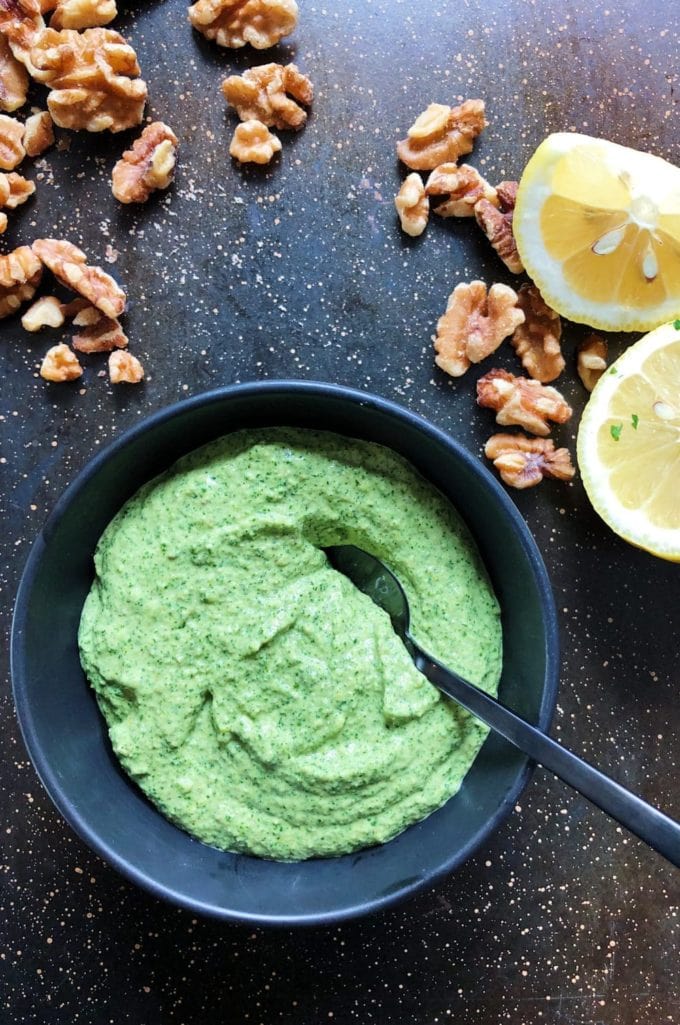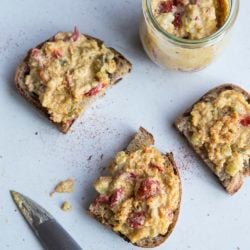Vegan Cilantro and Parsley Pesto Recipe

This delicious raw and vegan cilantro and parsley pesto recipe is packed with nutrients (like omega 3!) and super simple to make. Add it to pasta, as a topping on toast, a dressing… the possibilities are endless. This make-ahead recipe is also freezer-friendly and easily doubled.
There are few simple pleasures as perfect as a good pesto. And the dietitian in me has to admit that I get pretty excited that pesto makes it so easy (and delicious!) to fill up on nutrient-dense plant foods, which is kind of the whole modus operandi from the plant-based recipes here on the blog, and in my book Eat More Plants.
This vegan pesto recipe, studded with rich cilantro, zippy parsley and whole lemon, is no exception. It’s rich in omega 3 fatty acids, thanks to walnuts and hemp hearts, an important part of a healthy anti-inflammatory diet.
You’re going to want to eat this pesto on everything: pesto slathered on avocado toast. Or lavished on pasta, perhaps swirled into a creamy vegan pasta sauce Scrambled into tofu…or dressing a new potato salad. It’s a great meal prep recipe to have on hand for easy + flavourful meals.
How do you make vegan pesto?
Pesto hails from Genoa in Italy, where it is traditionally ground with a mortar and pestle into a thick paste-like sauce from basil, pine nuts, extra virgin olive oil, salt and parmesan cheese. Although most of us grew up on the basil-garlic-pine nut-parmesan version, I tend to think of pesto as a formula:
2 cups greens + 1/4 – 1/2 cup nut/seed + 1-2 garlic (always garlic!) + creamy/umami notes (formally known as cheese) + any additional flavours you want to add (like lemon etc) + oil
So to make a vegan pesto, you can see that really, we’re just looking to replace the creamy/umami notes. Which some folks do with a vegan parmesan…but I find that the flavour and quality varies so widely that I’d rather use a dependable (and whole food!) ingredient: nutritional yeast.
I’m particular about pesto…of course I am. You need olive oil, but I don’t like it too oily. Or too cheesy, because I don’t want to hide the greens. I am using parsley and cilantro in this recipe because they’re deeply flavourful (and nutritious!)..so why would we want to hide them!
I also like a lot of acid so it doesn’t taste flat. Ask my husband. He thinks I go a step too far on acid…but that’s a whole other story.
The easiest way to make a vegan pesto: in the food processor!
There are two main techniques for making a pesto in the food processor, depending on whether you want a loose sauce or a creamier one.
- For a creamier sauce, as pictured here: add all ingredients to the food processor at once and blend until smooth!
- For a looser sauce, pulse everything BUT the oil until it is finely chopped. Then, drizzle in oil while pulsing until it looks more like a loose, fine salsa.
Is pesto healthy?
As a dietitian, I am here to say that yes, vegan pesto is absolutely a healthy food. I mean, when was the last time you put 2 cups of herbs in a recipe?!?
There are some voices in the plant-based nutrition community that warn about consuming oils, but I don’t think that the current nutrition research backs this up. Take extra virgin olive oil, for example. It’s primary fat is oleic acid, a monounsaturated fatty acid associated with a healthy heart. Olive oil also contains polyphenols that support appropriate inflammatory response in the body as part of a healthy anti-inflammatory diet. In fact, one recent trial found that consuming olive oil was associated with 19% lower risk of dying overall.
I think that we get really hung up on super foods when anti-inflammatory nutrition is all about the everyday food heroes like greens, nuts and seeds that you can eat day in and day out. And pesto is literally greens, nuts, seeds, garlic and extra virgin olive oil. ALL of the good things. So eat it up.
Even better, this cilantro + parsley pesto contains ingredients specifically chosen for their nutrient density:
- Cilantro + parsley: they are inexpensive, nutrient-dense greens packed with plant-based phytochemicals that help to fight oxidative damage and inflammation.
- Omega 3-rich walnuts and hemp seeds boost your intake of these important anti-inflammatory fats.
- Garlic: a gut-friendly food rich in microbiome-boosting FODMAPs as well as sulfur-based phytochemicals that help squelch inflammation. Eating garlic raw delivers these phytochemicals in their most potent form.
- The nutritional yeast gives it that familiar umami note that traditionally comes from parmesan while boosting B vitamins that are important on a plant-based diet.
Vegan cilantro and parsley pesto ingredients
This delicious vegan pesto recipe requires just 9 ingredients (including salt!) and whips up in 5 minutes with minimal chopping. If you’ve got a ton of leftover herbs in the fridge, this is the way to use them up.
- curly parsley
- cilantro
- lemon
- walnuts
- hemp hearts
- nutritional yeast
- garlic
- salt
- extra virgin olive oil
Vegan Pesto Tips, Substitutions + Storage
- This pesto will keep very well for 3-4 days in the fridge. There might be a tiny bit of separation, just stir it up!
- You can use literally ANY nut or seed for this recipe, so no worries if you have nut allergies.
- Don’t have hemp hearts? Just add extra walnuts.
- Want a more traditional texture? Pulse the ingredients, minus oil, to chop, then drizzle in or whisk in the oil.
Ways to use this vegan pesto recipe
When you taste this pesto, it will taste strong – almost too strong – but the reason for that is that the flavour will dilute once it’s on pasta. You need a whole lot of flavour to stand up to those strands. But there are so many other ways you can use this recipe to liven up everyday dishes:
- Try adding a bit of mayo to make a sauce for grain bowls, potato salads or veggies.
- Spread it on sandwiches, wraps, pizza or anything else your heart desires.
- Swirl it into soups or toss it with a tofu scramble
- Add it to ready made dough and twist into pesto garlic knots
- Want a thinner sauce? Whisk in a little more olive oil or warm water
More easy vegan pasta sauces + pasta recipes

Vegan Cilantro and Parsley Pesto Recipe
Ingredients
- 1 cup curly parsley, leaves and tender stems, lightly packed
- 1 cup cilantro, leaves and tender stems, lightly packed
- ¼ cup walnut halves
- ¼ large lemon, skin on, seeds removed
- 2 tablespoons hemp hearts, (learn about the benefits of hemp hearts!)
- 1 tablespoon nutritional yeast
- 2 cloves garlic, peeled
- ½ teaspoon salt
- ¼ cup extra virgin olive oil, extra virgin
Equipment
- Food Processor or immersion blender
Instructions
- In a small food processor or large cup for blending, add the parsley, cilantro, walnuts, lemon, hemp hearts, nutritional yeast, garlic and salt. Pulse until finely chopped and uniform – or puree if using an immersion blender.
- Next, drizzle in olive oil while pulsing the mixture, to emulsify the pesto. If using an immersion blender, the mixture will have a creamier consistency when you blend.
- If adding pesto directly to pasta, toss pasta with a tiny drizzle of olive oil first to coat the strands so the pesto spreads a bit easier. Loosen up the pesto with a bit of pasta cooking water if you wish.
- Or store pesto in an airtight jar in the fridge for up to three to four days…if it lasts that long!




4 Comments on “Vegan Cilantro and Parsley Pesto Recipe”
I can’t wait to try this! I just received carrots from a friends garden. I may try this with carrot tops and parsley…what do you think?
Sounds awesome!! Carrot tops works so well in a pesto
I made a double batch tonight – absolutely delicious! My husband liked it too, even though he would not otherwise enjoy cilantro.
That’s high praise! If a cilantro hater is a fan…it must be a win 🙂 Thank you for taking the time to leave a rating Manuela!